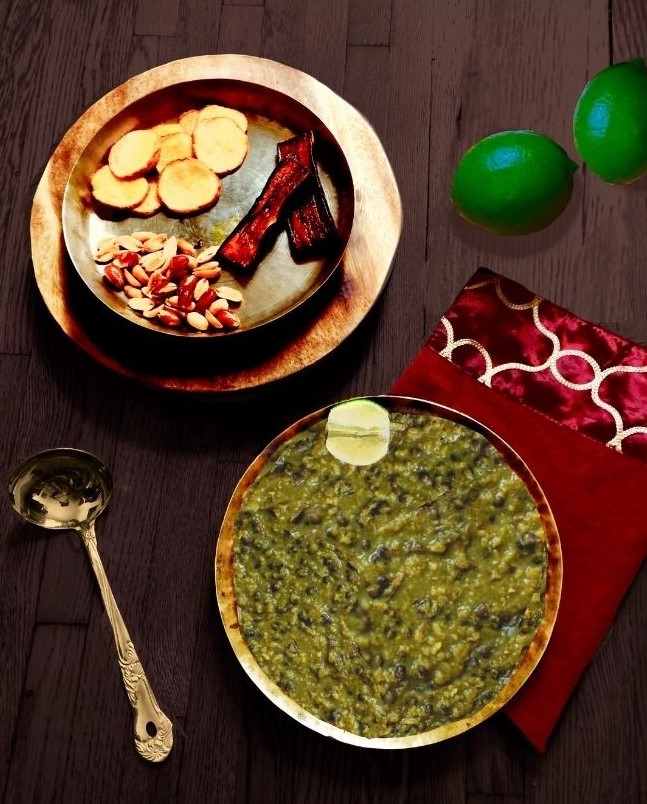Translated from the Bengali by Upama Mukherjee
Chaale Daale: A soft khichdi with unpolished maashkolai daal
Back in those days, post-lunch siesta for me was resting against Thakuma’s soft cold belly. And Dadu’s radio crooning…
Finishing up duties at the kitchen, she washed herself before stepping into the large room and I, like the most obedient girl that ever was, would spread the straw mat on and arrange the floral embroidered pillows and declare my intent—I was just going to rest my head for a bit on the shefali blossom embroidered pillow and not sleep at all.
It was Thakuma who taught me that shefali was the formal name for our very own shiuli flowers. When finally after settling on the shares of the pillows, Thakuma came in, chewing on her customary zarda-betel wrap, Dadu’s radio played songs of love—“Your love, my love…has me complete…”
The embroidered pillow, the numbing scent of her Hakimpuri zarda, the sound of the ceiling fan overhead, and those mellifluous amorous numbers… downed me softly, inevitably into a slumber. As the sleep deepened, I saw myself, Shukla, and Eetu playing around, doing household chores, and fighting over the Eucalyptus fruits under the shade of that very tree. I simply could not snatch my fruit, ever. Who knows why, dreams never let me win.
Thakuma would end up leaving me to sleep. In those days, arrangements for Durga puja would begin at least two months early around the time when they harvested the Aamon paddies.
The largest room of our house was a duplex with a tin roof. The upper story had large wooden boxes and terracotta dolas to store rice and a myriad of other grains.
The rice varieties had ornate names—kadambini, jhingeshail, nazirshail, deegha… Thakuma stepped down the wooden stairs, carrying the deegha rice, and with that ended my siesta too. Maa would be waiting in the open kitchen. Open, because it had no walls, just a raised tin roofing. This place was designated for the preparations of puffed rice, dhyaper moa, tiler kotkoti, and coconut laddus.
So the moment they fired up the hearth in the kitchen, I could smell the festival and follow after Thakuma who rushed and called and they started puffing the rice.
Maa and my other aunts, together poured the rice grains and sprinkled salt water on a broken earthen pan. When the rice began to sputter and bloom, Thakuma transferred them over the hot sand in another clay pot. Turning it a few times, she moved those small, red puffed rice into a sieve.
Right after it was sieved from the sand, a big brass bowl full of freshly puffed rice came my way. Adding a few drops of mustard oil over my warm muri, she said, “Ask your Chhotopishi for jaggery”. The rest of the afternoon slipped by relishing the warm muri with mustard oil and jaggery. On those busy afternoons, for dinner, Thakuma would go for a simple chaale-daale because it was easy to cook and was ready in a short time.
It was cooked in the same open kitchen. After all the rice puffing was done, the dinner was cooked over the last remaining fire in the hearth.
Chaale daale was put together with jingeshail rice and unpolished maash-kolai daal. Tampering the oil with cumin seeds in a brass kadhai, Thakuma put the grains in, added the turmeric and salt, and turned the mix a few times followed by a few green chilies and generous amounts of hot water. She waited for it to come to a boil and get done gradually. As the grains softened thickening the concoction, a handful of crushed ginger and some water went in and the pot was covered for the first time.
The aroma wafted and spread as if the fragrance of puja was along with it. The vermilion mark on Thakuma’s forehead melted in the dimming heat of the oven and began to roll down to the tip of her nose. When I went to wipe it off, she said, “You are my real one!”
By then, chaale daale was done to perfection and began to whittle at the edges of the pot. It was time to take it off. Everyone lined up for dinner the moment they heard the bay leaves and red chilies crackle in the oil for final tampering.
As I relished fried green peanuts by chhotopishi with my chaale daale with a dash of lemon juice, the radio went on, “You are listening to the Voice of America. This is the News at 10 pm. Dhaka rises in distress against President Mohammed Ershaad…”
The above is an excerpt from Smriti Bhadra’s book Roshui Ghorer Royak (Days In The Kitchen), first published in 2021. The book is a collection of eclectic recipes from the author’s bygone days. Not merely a book of recipes with meticulous instructions and information, it presents itself as a food memoir wherein the author reminisces about her life through myriad food items that are intrinsically entwined with her cultural identity. This is the third part of the series of the translated book. To read the first and the second parts, click on the following links:
To read the following fourth, fifth, and sixth parts, click on the following links:
Also, read a Bengali story by Premendra Mitra translated into English by Upasya Mukherjee, and published in The Antonym:
Follow The Antonym’s Facebook page and Instagram account for more content and exciting updates.




























0 Comments